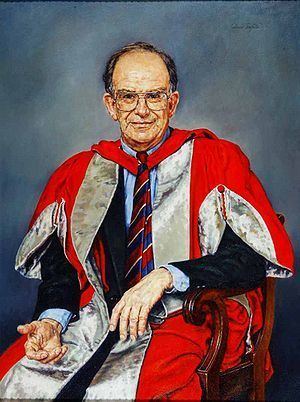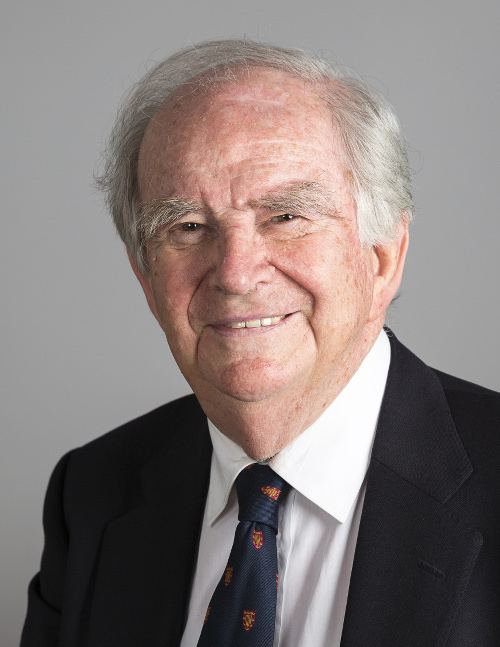Name John Thomas | Role Chemist | |
 | ||
Born 15 December 1932 ( 1932-12-15 ) Institutions Royal InstitutionUniversity of Cambridge Books Design and Applications of Single-site Heterogeneous Catalysts: Contributions to Green Chemistry, Clean Technology and Sustainability People also search for W. J. Thomas, J. M. Thomas, Ahmed Zewail, David Chilton Phillips Died 13 November 2020 (aged 87) | ||
Interview of john meurig thomas 2007 part 1
Sir John Meurig Thomas FLSW FRS HonFREng (15 December 1932 – 13 November 2020) was a British chemist and educator primarily known for his work on heterogeneous catalysis, solid-state chemistry, and surface and materials science. Thomas has authored over one thousand scientific articles and several books, including Principles and Practice of Heterogeneous Catalysis (with W. John Thomas) and Michael Faraday and the Royal Institution: The Genius of Man and Place.
Contents
- Interview of john meurig thomas 2007 part 1
- Interview of john meurig thomas 2007 part 3
- Early Life and Education
- Early career
- Director of the Royal Institution
- Return to Cambridge
- Awards and honours
- Books
- Part 1 On the design and application of solid catalysts
- Part 2 On new techniques
- References

In 1991 Thomas was knighted "for services to chemistry and the popularisation of science". The mineral meurigite is named after him. Much of his research has involved creating new solid catalysts and trying to understand the structure and activity of existing ones using techniques such as X-ray absorption, NMR spectroscopy, and high resolution transmission electron microscopy. Thomas is one of the most cited authors in the field of heterogeneous catalysis. In recent years, he has focused on designing green chemistry catalysts for clean technology and on developing ways of studying catalysts in situ.
Interview of john meurig thomas 2007 part 3
Early Life and Education
Thomas was born and brought up near the Welsh mining town of Llanelli, South Wales where his father and brother were miners. His interest in science was aroused when as a teenager he heard his physics teacher at Gwendraeth Grammar School talk about the life and work of Michael Faraday. Later in life, Sir John would become the Fullerian Professor of Chemistry at the Royal Institution of Great Britain, in London, a position held by Michael Faraday, who has remained one of his scientific heroes.
Thomas holds BSc (1954) and PhD (1958) degrees from the University of Wales, Swansea, although he completed the work for his PhD at Queen Mary College, University of London, where his advisor, Keble Sykes, had moved.
Early career
After a year's work for the United Kingdom Atomic Energy Authority as scientific officer he joined the Department of Chemistry at the University of Wales, Bangor where he rose through the ranks from Assistant Lecturer, to Lecturer, and then to Reader. In 1959 he married Margaret Edwards (deceased 2002) with whom he later had two daughters, Lisa and Naomi. While at Bangor, he demonstrated the profound influence that dislocations and other structural imperfections exert upon the chemical, electronic, and surface properties of solids.
In 1969 he became Professor and Head of Chemistry at the University College of Wales, Aberystwyth, where he broadened his interests in solid-state, surface and materials chemistry and pioneered the application of electron microscopy in chemistry. In 1977 he was elected a Fellow of the Royal Society.
From 1978 to 1986, Thomas was at the University of Cambridge as Head of the Department of Physical Chemistry (then a separate department from the Department of Chemistry, which covered Organic, Inorganic and Theoretical Chemistry) and Professorial Fellow at King's College, Cambridge. There he continued developing new techniques in solid-state and materials science, and designing and synthesizing new catalysts. For example, he extended his earlier electron microscopic and surface studies of minerals and intercalates to encompass the synthesis and structural determination of zeolitic materials by a combination of solid-state NMR, neutron scattering, and real-space imaging.
Director of the Royal Institution
In 1986 he was invited to succeed Sir George Porter as Director of the Royal Institution of Great Britain, London, occupying with his family the same living quarters that Michael Faraday and his wife had occupied at the Royal Institution's building on Albemarle Street. At this time, he began using synchrotron radiation and devised techniques which combine X-ray spectroscopy and high-resolution X-ray diffraction to determine the atomic structure of the active sites of solid catalysts under operating conditions. He also devised new mesoporous, microporous, and molecular sieve catalysts. In 1987 the BBC televised his Royal Institution Christmas Lectures on crystals, continuing the tradition of lectures for children started by Faraday in 1826. He resigned as Director in 1991 owing to his wife's health, but remained associated with the Davy Faraday Research Laboratory of the Royal Institution until 2006. In 1991 he published the book Michael Faraday and the Royal Institution: The Genius of Man and Place, which has since been translated into Japanese (1994) and Italian (2007).
Return to Cambridge
After a period as Deputy Pro-Chancellor of the University of Wales (1991–1994), he returned to Cambridge in 1993 as Master of Peterhouse, Cambridge's oldest college, and as Honorary Distinguished Research Associate in the Department of Material Science, both of which posts he held until 2002, the year his wife died. During his tenure as Master of Peterhouse, Lady Thomas oversaw the magnificent renovation of the Master's Lodge, a 1702 mansion on Trumpington Street.
In 1997 he co-authored with W. John Thomas (no relation) the text Principles and Practice of Heterogeneous Catalysis. In 1999 he was elected Honorary Fellow of the Royal Academy of Engineering for work that "has profoundly added to the science-base of heterogeneous catalysis leading to the commercial exploitation of zeolites through engineering processes".
He is the author of some thirty patents, some of which have made chemical processes more environmentally benign ("greener") by eliminating the use of solvents and reducing the number of manufacturing steps involved. The single-step, solvent-free catalytic synthesis of ethyl acetate that he invented is the basis of a 200,000 ton/year plant in the UK, the largest of its kind in the world. He has recently devised single-step, solvent-free processes for the production of caprolactam (the raw material for nylon-6) and vitamin B3 (niacin).
Awards and honours
Since 2002 he has been Honorary Professor of Materials Science at the University of Cambridge and Emeritus Professor of Chemistry at the Davy Faraday Research Laboratory of the Royal Institution. He also holds an Honorary Distinguished Professorship of Materials Chemistry at Cardiff University, an Honorary Distinguished Professorship of Materials Chemistry at the University of Southampton, and an Honorary Distinguished Professorship of Chemistry and Nanoscience at the University of York. He is an Advisory Professor at Shanghai Jiao Tong University as well as at the Catalysis Center of Hokkaido University. He was recently appointed to the Advisory Committee on Science, Wales. He is an Honorary Bencher of Gray's Inn.
He is the recipient of twenty honorary degrees from Australian, British, Canadian, Chinese, Dutch, Egyptian, French, Italian, Japanese, Spanish, and U.S. universities, including an Honorary Doctorate from Heriot-Watt University in 1990. He has been elected to honorary membership in over fifteen foreign academies, including the Royal Swedish Academy of Sciences, the American Philosophical Society, the American Academy of Arts and Sciences, the Accademia dei Lincei (Rome), and the Russian Academy of Sciences.
His recent awards include the Kapitza Gold Medal from the Russian Academy of Natural Sciences (2011), the Jayne Prize Lectureship of the American Philosophical Society (2011), the Bragg Prize Lectureship of the British Crystallographic Association (2010), the Sven Berggren Prize Lectureship, Lund (2010), the Ertl Prize Lectureship of the Max Planck Gesellschaft (2010), the Sir George Stokes Medal from the Royal Society of Chemistry (2005), the Giulio Natta Gold Medal from the Società Chimica Italiana (2004), the Linus Pauling Gold Medal from Stanford University (2003), and the American Chemical Society Annual Award (first recipient) for Creative Research in Heterogeneous and Homogeneous Catalysis (1999). He has won the Davy Medal of the Royal Society and the Faraday Lectureship Prize of the Royal Society of Chemistry. In 1995 he became the first British scientist in 80 years to be awarded the Willard Gibbs Award by the Chicago Section of the American Chemical Society. In recognition of his contributions to geochemistry, a new mineral, meurigite, was named after him in 1995 by the International Mineralogical Association.
His 75th birthday (attended by Angela Merkel and Ahmed Zewail) was celebrated with a symposium and several musical and social events at the University of Cambridge. The papers presented at the symposium were published in 2008 by the Royal Society of Chemistry as Turning Points in Solid-State, Materials and Surface Science: A Book in Celebration of the Life and Work of Sir John Meurig Thomas. In 2010 Imperial College Press published 4D Electron Microscopy: Imaging in Space and Time, which he co-authored with Ahmed Zewail (Nobel Laureate, Chemistry, 1999). His most recent publication is Design and Applications of Single-Site Heterogeneous Catalysts: Contributions to Green Chemistry, Clean Technology and Sustainability, which has been praised as follows:
A true marriage of the practical and the fundamental, John Thomas's masterly account of single site heterogeneous catalysts, a remarkably effective form of matter guiding desired chemical transformation, is a sheer joy to read. With the synthetic flair of Humphry Davy and the brilliance of his hero Faraday, we are led by the author to a feast of contemporary masterworks of chemical reactivity, prodded, by design, into the service of humanity.
In April 2010 Sir John married Jehane Ragai of the American University in Cairo; the events took place in Cambridge and London. The recreations he lists in Who's Who include ancient civilisations, bird watching, and Welsh literature. In 2003, he was the first scientist to be awarded the Medal of the Honourable Society of Cymmrodorion (London) for services to Welsh culture and British public life. He is also a Founding Fellow of the Learned Society of Wales and a Member of its inaugural Council. Since 2011 he has been a member of the Scientific Advisory Committee for Wales. He is an overseer of the Chemical Heritage Foundation (Philadelphia), and a member of the International Advisory Board of the Zewail City of Science and Technology (Egypt).
He was also appointed as a Honorary Fellow of the Royal Academy of Engineering in 2013. In 2016, Professor Sir John Thomas was conferred an Honorary Fellowship by Beijing Normal University-Hong Kong Baptist University United International College (UIC), in view of his distinguished achievements in catalysis and materials science, and his dedication and outstanding contributions to the popularisation of science.
In October 2016 the Royal Society awarded Sir John the Royal Medal for Physical Sciences "for his pioneering work within catalytic chemistry, in particular on single-site heterogeneous catalysts, which have had a major impact on green chemistry, clean technology and sustainability." The Duke of York represented Her Majesty the Queen at the ceremony. Also in 2016, the UK Catalysis Hub launched a new medal "honouring the achievements of Sir John Meurig Thomas, a distinguished professor in the field of catalysis." The JMT Medal will be awarded every year, to a person working in the United Kingdom, for outstanding achievement in catalysis or a closely related field.
